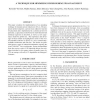Free Online Productivity Tools
i2Speak
i2Symbol
i2OCR
iTex2Img
iWeb2Print
iWeb2Shot
i2Type
iPdf2Split
iPdf2Merge
i2Bopomofo
i2Arabic
i2Style
i2Image
i2PDF
iLatex2Rtf
Sci2ools
FPL
2008
Springer
2008
Springer
A technique for minimizing power during FPGA placement
This paper considers the implementation of an annealing technique for dynamic power reduction in FPGAs. The proposed method comprises a power-aware objective function for placement and is implemented in a commercial tool. In particular, a capacitance model based on multi-dimensional nonlinear regression is described, as well as a new capacitance model for global nets. The importance and advantages of these models are highlighted in terms of the overall attainable reduction in power in a real, commerciallyavailable architecture and tool flow. The results are quantified across a range of industrial benchmarks targeting the Actel R IGLOO TM FPGA architecture. Power measurements show that, across a suite of 120 industrial designs, the technique described in this paper reduces dynamic power by 13% on average, with only a 1% degradation in timing performance.
Related Content
| Added | 26 Oct 2010 |
| Updated | 26 Oct 2010 |
| Type | Conference |
| Year | 2008 |
| Where | FPL |
| Authors | Kristofer Vorwerk, Madhu Raman, Julien Dunoyer, Yaun-chung Hsu, Arun Kundu, Andrew A. Kennings |
Comments (0)

